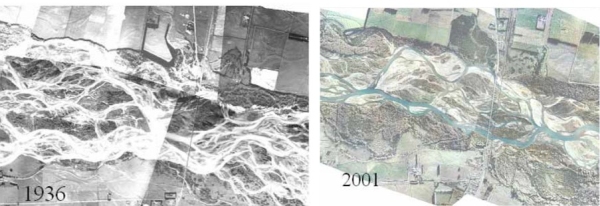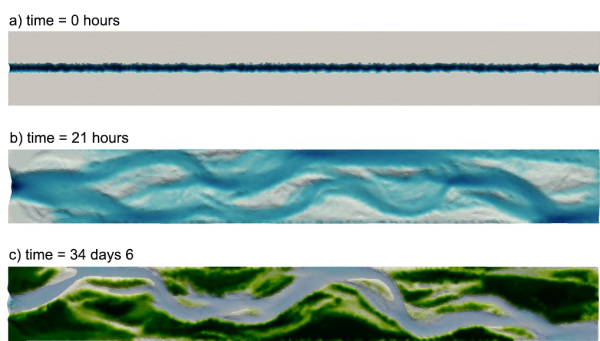NIWA is developing numerical models for predicting how the morphology of braided rivers responds to flow regulation and invasive exotic woody vegetation.
The Issue
Braided rivers provide high ecological and landscape values, and New Zealand has many of the few left in the world that retain a reasonably natural character. They occur where there are readily available supplies of sandy/gravelly “bedload” material plus channel slopes and flows adequate to transport this material downstream. The braiding channel form is dynamic and results from the complex interaction between flows and sediment transport—with transport, erosion and deposition of sediment continually changing the morphology and location of braided channels and hence the distribution of flow and the local hydraulic parameters that drive the transport. Braiding tendency can be reduced by reduced river flows and sediment supplies and also by riparian vegetation. Vegetation, particularly resilient woody species (e.g. broom, gorse, willow), stifles braiding processes by adding strength to braid banks, hiding gravel supplies in banks, and focussing flows into main channels, which then incise and enlarge, drawing flow away from minor braids.
Floods are usually potent enough to keep woody vegetation in check, but when floods are regulated by dams or irrigation diversions (or even by natural lakes upstream), and/or when an aggressive exotic plant species appears, the vegetation can gain ascendency and reduce braiding, even forcing the river into a single meandering channel. An example is provided by the South Island’s Lower Waitaki River, which, by the combined effects of hydro-power-related flow regulation and the arrival in the 20th century of willow, gorse, and broom, has trended historically towards diminished braiding.
Indeed, it is likely that it remains braided now only by virtue of an artificial vegetation control program using machines and spraying (directed primarily at preserving the river flood conveyance). Other New Zealand braided rivers are potentially threatened by future water-use schemes, notably those associated with “harvesting” of flood flows into storage reservoirs, and by newly arrived aggressive exotic plants (e.g., tamarisk).
To manage such situations it is necessary to predict the effects of a change in flood regime or vegetation clearing programme on braiding tendency. At present, though, scientists can only give partial answers based on analysis of changes observed in the patterns of braiding on historical aerial photographs.
The solution
The ability to quantitatively forecast morphological changes under different/alternative river flow and management scenarios in these complex natural systems ultimately calls for the development of numerical models that capture the key processes. Led by visiting Marie Curie Fellow Dr Gu Stecca and assisted by student Davide Fedrizzi (University of Trento, Italy), NIWA’s Sediment Processes Group has recently made a step forward on this objective, making advances in coding into Stecca’s physics-based GIAM2D model key processes that drive lateral migration of braided channels and flow/vegetation interactions. The vegetation module accounts in a simplified manner for vegetation growth between floods and removal by floods, and adjusts for the local flow drag due to vegetation.
The Results
The enhanced GIAMT2D model has been successfully tested by reproducing the morphodynamic evolution of a braided channel in a set of flume experiments that used alfalfa sprouts to simulate woody vegetation. Undertaken by Dr Michal Tal for a PhD study inspired by the Lower Waitaki River case, the experiments began with a braided morphology (Figure 3b) that had evolved at constant high flow over a bed of bare uniform sand from an initially straight single channel with no vegetation. The braided morphology was then observed to transition to a single-thread channel when this high flow was repeatedly cycled between periods of low flow with vegetation seeding and growth. Our preliminary numerical modelling results reproduced the same pattern of morphological evolution as observed in the laboratory experiments.
An example numerical model run is shown on the following simulation of the evolution of a fluvial reach at laboratory scale starting from an initially straight channel (Tal and Paola, 2010), using the modified GIAMT2D model. The first phase is about the development of a braided network in a bare, cohesionless sand bed. The second phase is composed of 31 cycles of vegetation growth at low flow, each one followed by a short high-flow phase which removes vegetation within channels, by which the braiding morphology progressively reduces to much a more static morphology with reduced braiding intensity.
Without vegetation present, the grey-scale provides a shaded-relief image of the dry bar topography while the blue-scale maps channel water depth. With vegetation present, the green-scale maps the vegetation biomass density on bars.
Conclusion
As a first step in developing a numerical model for predicting the response of braided rivers to altered flood regimes and invasion by aggressive exotic vegetation, we have built a physics-based 2D numerical model for vegetation-driven river morphodynamics and tested it successfully against laboratory experiments. Our current and future work aims to simulate decadal-scale evolution of a reach on the Waitaki River, compare this against evidence of braiding change off historical aerial photographs, and ultimately be able to predict braiding characteristics under different flow regimes and vegetation management scenarios for any braided river.
Further information
Bertoldi, W., Siviglia, A., Tettamanti, S., Toffolon, M., Vetsch, D., and Francalanci, S. (2014). Modeling vegetation controls on fluvial morphological trajectories. Geophysical Research Letters, 41:7167–7175.
Hicks M. North Bank Tunnel Concept—Water Consents: River Geomorphology, Sediment Transport, Coastal Processes and Flood Hazard Management. NIWA Client Report: CHC2006-090 prepared for Meridian Ltd, 2006.
Siviglia, A., Stecca, G., Vanzo, D., Zolezzi, G., Toro, E. F., and Tubino, M. (2013). Numerical modelling of two-dimensional morphodynamcs with applications to river bars and bifurcations. Advances in Water Resources, 53:243–260.
Tal, M. and Paola, C. (2010). Effects of vegetation on channel morphodynamics: results and insights from laboratory experiments. Earth Surface Processes and Landforms, 35(9):1014–1028.
Project funding
This project has received funding from the European Union’s Seventh Framework Programme for research, technological development and demonstration under grant agreement no. PIOF-GA-2013-621886, and by NIWA's Sustainable Water Allocation Programme.
396, 5326, 25




